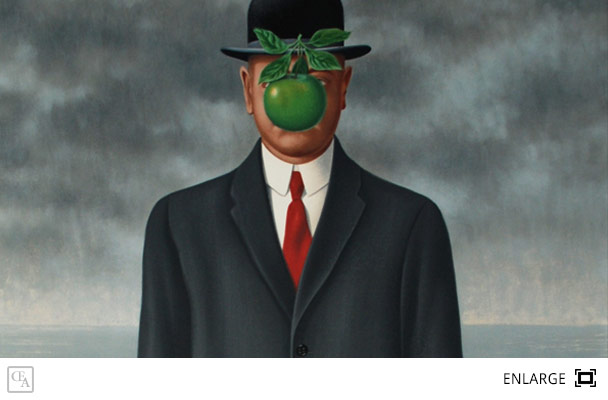
In the painting, a man in a dark suit and red tie wearing a white dress shirt and a dark bowler hat stands entirely before the viewer. Behind him there is a wall that appears to be made of cinder blocks and rises up to about the level of his hips. Behind that, one can see a body of water, most likely the sea. Above the sea, there is an overcast sky that gives the painting something of a gloomy tone, a stark white background with dark gray clouds.
The most striking part of the painting, however, is in the foreground. Here, an inexplicable green apple hovers before the subjects face, blocking his features from view. The apple is unremarkable, with a stem and four symmetrical leaves intact. Still, the subject appears to be somehow peering through the apple and towards the viewer, in the style of a normal portrait that is being somehow interrupted by the presence of the fruit. The viewer can just barely see the white of his left eye past the edge of the apple, suggesting that he is staring straight ahead. Another slightly off-putting aspect of the painting is the subject's left arm, which seems to be somewhat deformed in that the joint of the elbow is bending backward.
This painting has many elements in common with another one of Magritte's paintings, The Great War on Facades, which instead depicts a woman in a similar situation near a wall by the sea, with a flower hovering over her face. In addition, it is very similar to the painting Man in the Bowler Hat, which features a bust portrait of a man in a similar dress with a bird in front of the subject's face. All three of these paintings appear to deal with the theme of obscuring the true self from an audience.
The meaning of the painting is cryptic, but one can extrapolate some meaning from the words of Magritte himself. He spoke specifically of that feeling of human curiosity, where one seeks to see the hidden things that exist behind the other objects that we see, but one is often frustrated in this pursuit. The painting appears to capture this frustration—or “conflict,” as Magritte put it—by allowing us only a slight glimpse of the man's face behind the fruit. The deeper meaning of this conflict, and whether it speaks of the incidental hiddenness of objects behind other objects, or whether it speaks of the human conflict of wanting to hide ones true face from the prying eyes of others, is up to interpretation. At face value, however, it is an interesting exercise in stirring the curiosity of the viewer and making him feel as if he is not seeing the whole picture, leaving him slightly unsatisfied and with a sense of mystery about what he has seen.
 Arts3 Network
Website edition
Arts3 Network
Website edition